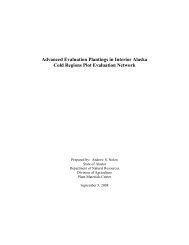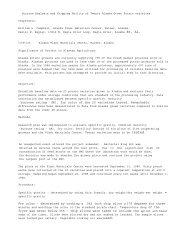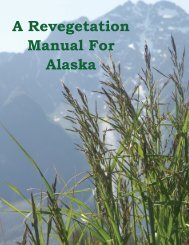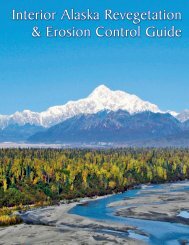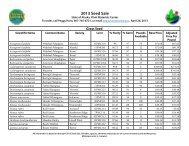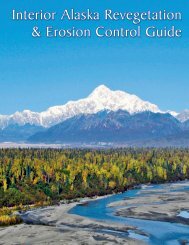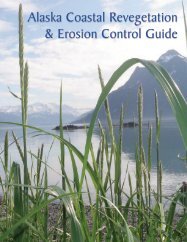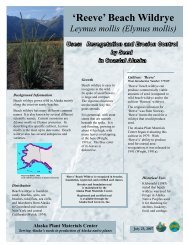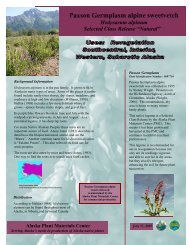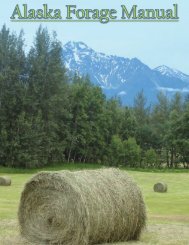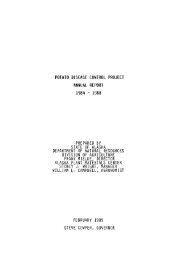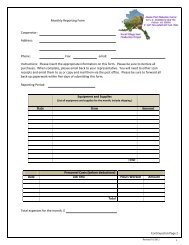Alaska Forage Manual - Alaska Plant Materials Center - State of ...
Alaska Forage Manual - Alaska Plant Materials Center - State of ...
Alaska Forage Manual - Alaska Plant Materials Center - State of ...
Create successful ePaper yourself
Turn your PDF publications into a flip-book with our unique Google optimized e-Paper software.
Pastures should not be grazed prior to attaining a minimum<br />
height <strong>of</strong> about 10 inches at the beginning <strong>of</strong> the grazing<br />
season. Grazing pressures should be adjusted throughout the<br />
season to avoid grazing this grass below a minimum height <strong>of</strong><br />
4 inches.<br />
Grasshoppers and seed blight can be a factor during grass<br />
establishment, in semi-humid areas. Foliar diseases in humid<br />
areas have also been known to cause serious problems.<br />
Smooth Brome can be dramatically affected by seed midges,<br />
such as Stenodiplosis bromicola, in some northern areas.<br />
Photo: <strong>Alaska</strong> PMC<br />
Grass<br />
Cultivars and Releases<br />
• ‘Carlton’ - Western Canada release.<br />
• ‘Manchar’ - Washington release.<br />
• ‘Polar’ - <strong>Alaska</strong> developed ‘Polar’ Brome may become<br />
commercially available in the future. Check with the<br />
<strong>Alaska</strong> <strong>Plant</strong> <strong>Materials</strong> <strong>Center</strong> for further detail.<br />
References<br />
I<br />
I<br />
SC<br />
SC<br />
Klebesadel, L.J. (1983) <strong>Forage</strong> Crops In <strong>Alaska</strong> - Bulletin 63, University <strong>of</strong><br />
<strong>Alaska</strong>, School <strong>of</strong> Agriculture and Land Resource Management, Agricultural<br />
Experiment Station. 16 pp<br />
Klebesadel, L.J., R.L. Taylor, W.M. Laughlin, W.W. Mitchell, G.J. Michaelson<br />
and J. Purser (1983) Grain and <strong>Forage</strong> Crops for Southcentral <strong>Alaska</strong>,<br />
University <strong>of</strong> <strong>Alaska</strong>, Palmer, <strong>Alaska</strong>. 10 pp<br />
Smooth brome, Bromus inermis<br />
Klebesadel, L.J. (1992) Bromegrass in <strong>Alaska</strong>. I. Winter Survival and <strong>Forage</strong><br />
Productivity <strong>of</strong> Bromus Species, Types, and Cultivars as Related to Latitudinal<br />
Adaptation, University <strong>of</strong> <strong>Alaska</strong> Fairbanks, School <strong>of</strong> Agriculture and Land<br />
Resources Management, Bulletin 87, 13 pp<br />
Stubbendieck, J., S.L. Hatch, L.M. Landholt (2003) A Field Guide, North<br />
American Wildland <strong>Plant</strong>s. University <strong>of</strong> Nebraska, University <strong>of</strong> Nebraska<br />
press. Lincoln, Nebraska. 501 pp<br />
Maurice, E.H., D.S. Metcalfe, R.F. Barnes (1973) <strong>Forage</strong>s, The Science <strong>of</strong><br />
Grassland Agriculture. Iowa <strong>State</strong> University Press, Iowa <strong>State</strong> University.<br />
Ames, Iowa. 755 pp<br />
Natural Resource Conservation Service (2000) USDA National <strong>Plant</strong> Data<br />
<strong>Center</strong> [online] Link: http://plants.usda.gov/java/<br />
Pawnee Buttes Seed Inc. (2004) A Guide to Grasses, Pawnee Butte Seed Inc.,<br />
Greeley, Colorado. 107 pp [online] Link: http://www.pawneebuttesseed.<br />
com/guide_to_grasses.htm<br />
Soil Conservation Service (1972) A Vegetative Guide for <strong>Alaska</strong>. University<br />
<strong>of</strong> <strong>Alaska</strong>, Institute <strong>of</strong> Agricultural Sciences, Soil Conservation Service. 50 pp<br />
Skinner, Q.D. (2010) A Field Guide to Wyoming Grasses. Education Resources<br />
Publishing, Cummings Georgia. 596 pp<br />
I<br />
SC<br />
Klebesadel, L.J. (1970) Influence <strong>of</strong> <strong>Plant</strong>ing Date and Latitudinal Provenance<br />
on Winter Survival, Heading, and Seed Production <strong>of</strong> Bromegrass and<br />
Timothy in the Subarctic, University <strong>of</strong> <strong>Alaska</strong> Experiment Station In Crop<br />
Science, Vol. 10. Sept.-Oct. 1970. p 594-598.<br />
Coarse<br />
Moderately<br />
Coarse<br />
Soil Texture *<br />
Medium<br />
Moderately<br />
Fine<br />
1 3 3 3 2<br />
Fine<br />
* Soil texture is graded on a scale <strong>of</strong> 0 to 3; higher numbers<br />
denote textures to which species is most adapted.<br />
Species not<br />
adapted to region<br />
Adapted Regions:<br />
Smooth Brome<br />
• Interior<br />
• Southcentral<br />
see variety detail at left<br />
Availability<br />
Growth<br />
Form<br />
Average<br />
Height<br />
Native or<br />
Introduced<br />
Saline<br />
Tolerance<br />
Drought<br />
Tolerance<br />
Wet Soil<br />
Tolerance<br />
Competitiveness<br />
pH Range<br />
56<br />
Good Sod 12 - 18 in. Introduced Poor Good Fair Strong 6.0 - 7.5



